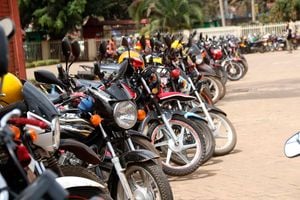Iconic ‘Drum’ magazine opens store in South Africa

The Drum Magazine Archive store in Johannesburg, South Africa.
For the generations of Africans who grew up with Drum magazine as a must-reading, that famous logo with the name of the publication in white over a red background evokes fond memories.
During its heyday, the iconic title was the most widely read magazine across Africa chronicling the realities of life in the black townships of South Africa during apartheid. Its popularity transcended borders, becoming a symbol of urban life for Africans across the continent.
The legacy of the publication is now accessible to a whole new generation in fresh, creative formats that celebrate this symbol of black urbanization and the social and political struggles of the African liberation movement
The Drum Archive Store, opened just over a year ago, at 44 Stanley, Braamfontein Werf, downtown Johannesburg, is located in a unique setting of arcades and green courtyards, an artsy space that also houses a book store, restaurants, and a vinyl record store.
The sign on the building will catch the eye of anyone who flipped through the pages of the influential magazine for riveting content by some of Africa’s best writers. Once inside the brightly lit store, one is attracted by the portraits of some of the legendary Drum magazine covers and a whole range of merchandise, including handbound notebooks, t-shirts, and mugs, all depicting a slice of the publication’s history.
Part of the proceeds from the sale of merchandise goes towards the digitization project of Bailey’s African History Archive (named after founder Jim Bailey) which holds more than 30 years’ worth of magazines and thousands of photographs. “The digitization of magazines is quite urgent because the archive is quite fragile,” says Sandra Matutoane who has worked at the store since its opening.
Matutoane acknowledges that digitising the archive which is a project that started about two years ago is “slow and steady work” but Bailey’s African History Archive website has a comprehensive collection of the magazine covers, articles and information about the magazine’s legendary journalists.
According to her, while most of the visitors are locals, there are more international visitors/ tourists who are discovering the store daily. “Our customers vary in age but are mostly professionals, academics and people who love Drum for its place in their lives,” she says. “The Generation Zs love the vintage appeal of the imagery and are genuinely curious to discover more about the historical significance of the magazine.
Some of the most popular portraits are the first cover of the magazine with featured an artist’s impression of an African drum, a young Winnie Mandela in October 1965, and anti-apartheid activist Steve Biko on the cover of the November 1977 issue, two months after he was beaten to death by security officers.
History
The African Drum, as the magazine was originally called, was started in March 1951 by a group of investors led by Jim Bailey, a British-born publisher who had served as a fighter pilot during World War II. Those early editions were a failure, circulation was low as the magazine suffered from what was viewed as a paternalistic attitude to African issues.

Inside the Drum Magazine Archive store in Johannesburg, South Africa.
Eventually, Bailey took full control, financing the magazine with an inheritance from his dad Sir Abe Bailey, a wealthy gold mine owner. He replaced founding editor Robert Crisp with another Briton, Antony Sampson, who immersed himself in township life as a regular in the shebeens (informal taverns) and the jazz venues (Simpson authored The Authorized Biography of Nelson Mandela in 1999).
As Matutoane explains, on the face of it, Drum was a lifestyle magazine with glamorous pin-up cover models, but beneath the surface, the publication was deeply political challenging the apartheid system. “The beautiful girls on the cover were a camouflage for stories on the deep struggles of Africans under apartheid and the liberation movement,” she says.
Drum provided a platform for a generation of intrepid reporters, notably Henry “Mr Drum” Nxumalo, the first African journalist at its inception, whose undercover investigations exposed the brutal treatment of African labourers in the potato farms in the Bethal district of the Transvaal in 1952.
The magazine also covered events in other parts of Africa, as it did in December 1952 with an article on the Mau Mau rebellion against colonial rule in Kenya, while pioneer Kenyan scholar and freedom fighter Dr Julius Kiano reported for Drum on the resolutions of the All-African People’s Congress in Accra in 1958.
Vivid photography
Drum, under veteran journalist, Tom Hopkinson, who took over the stewardship in 1958, gave prominence to vivid photography to illustrate social, political and cultural stories. German-born South African photographer Jurgen Schadeberg took pictures of icons of the freedom movement notably Nelson Mandela, Walter Sisulu and Govan Mbeki and documented music greats like Hugh Masekela, and Miriam Makeba.
Schadeberg’s photo session with bikini-clad singer Dolly Rathebe at a Johannesburg mine dump for the Drum July 1955 cover, was interrupted when police arrested them both for ostensibly contravening the Immorality Act which outlawed interracial relationships.
One of Schadeberg’s proteges, Peter Magubane, who joined Drum as a young cameraman and covered momentous events like the Sharpeville Massacre (1960) and the Rivonia Trial (1963-64), became Nelson Mandela’s official photographer in the 1990s during the transition from apartheid to the early years of his presidency.
Previously unseen photos from the Rivonia Trial of 1964 will be released in the next few weeks from the Drum archives and Matutoane is very excited about the collection, notably an image of a relaxed Mandela eating a sandwich during a break in the trial.
“These photos provide a powerful telling of history for all generations,” says Matutoane who states that creating something that didn’t exist before and jointly making decisions that grow the Drum brand, is the most rewarding aspect of her job.




